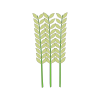Barley (Hordeum vulgare L.) is a cereal grain belonging to the grass family Poaceae. It is one of the world’s oldest cultivated crops, domesticated over 10,000 years ago in the Fertile Crescent. Barley is valued for its versatility, serving as food for humans, feed for livestock, and a key ingredient in brewing and distilling industries.
The barley plant is an annual grass with an upright, hollow stem called a culm, which typically grows between 60 to 120 cm tall. The stem bears long, narrow leaves with parallel veins and a rough texture. Each plant develops several tillers (side shoots) that can produce additional grain heads, enhancing yield.
At the top of the stem forms a spike (or head) consisting of tightly packed rows of kernels (grains). Depending on the variety, barley may have two-row or six-row arrangements of grains along the central axis, or rachis. Each grain is enclosed by protective glumes and awns, which can vary in length and roughness.
Barley thrives in cool, temperate climates and is notable for its tolerance to drought and salinity, making it a hardy crop adaptable to diverse environments. It grows best in well-drained, fertile soils and completes its life cycle in about 90–120 days.
The harvested barley grains are rich in starch, protein, dietary fiber (especially β-glucans), and essential minerals. They are used in a variety of forms — pearled barley for soups and cereals, malted barley for beer and whiskey production, and as a nutritious component in animal feed
How To Grow
-
Choose the Right Variety
Barley comes in different types suited for various purposes and climates:
Two-row barley – Often used for malting (beer and whiskey).
Six-row barley – Usually grown for animal feed.
Hulled barley – Grains have tough outer husks.
Hull-less (naked) barley – Easier to process for food use.
Choose a variety adapted to your local climate and soil conditions.
-
Select the Planting Time
Spring barley – Sown in early spring when the soil can be worked; harvested in late summer.
Winter barley – Sown in autumn (fall); grows slowly through winter and is harvested in early summer.
Choose based on your region’s temperature and frost patterns.
-
Prepare the Soil
Barley prefers well-drained, loamy or sandy soils with pH 6.0–7.5.
Avoid waterlogged areas.
Before planting, plow or till the soil to loosen it.
Mix in compost or balanced fertilizer (especially nitrogen and phosphorus) to encourage early growth.
-
Planting
Sow seeds directly into the soil — no need to start indoors.
Plant about 2.5–5 cm (1–2 inches) deep.
Keep rows 15–20 cm (6–8 inches) apart.
Use roughly 90–110 kg of seed per hectare (or about 80–100 pounds per acre).
Cover seeds lightly with soil and press down gently.
-
Watering and Care
Barley needs moderate water, especially during germination and early growth.
Avoid overwatering; barley does not tolerate standing water.
Keep the area weed-free, especially in the first few weeks.
If needed, apply a light nitrogen fertilizer at the tillering stage (when side shoots form).
-
Pest and Disease Managemen
Watch for:
Aphids (can spread barley yellow dwarf virus)
Leaf rust, powdery mildew, and smut
Use disease-resistant varieties and rotate crops (avoid planting barley after other cereals).
How/When To Harvesting
-
Know When It’s Ready
Barley is ready to harvest when:
The plants turn golden-yellow or light brown.
The stems and leaves are dry and brittle.
The grains are hard when pressed between your teeth — not soft or milky.
The moisture content of the grain is around 12–14% (for safe storage).
A simple test: Shake a few heads — if grains fall out easily, it’s harvest time.
-
Choose the Right Time of Day
Harvest on a dry, sunny day.
Avoid early mornings (dew) or after rain, as moisture can cause mould or spoilage.
-
Harvesting Methods
For Small Plots or Gardens
Cutting:
Use a sickle, scythe, or sharp knife to cut the barley stalks 10–15 cm (4–6 inches) above the ground.
Bundling:
Gather the stalks into small bundles (called sheaves) and tie them loosely.
Drying:
Stand the sheaves upright in the sun for 7–10 days to let them dry completely.
Protect them from rain or heavy dew.
For Large-Scale Farming
Use a combine harvester, which cuts, threshes, and separates the grains in one operation.
Adjust the machine’s settings to barley-specific moisture and kernel size to minimize grain loss or damage.
-
Threshing (Separating Grain from Straw)
If done by hand:
Spread the dried heads on a clean tarp or hard surface.
Beat them gently with a stick or flail to loosen the grains.
Collect the grains and discard the straw.
-
Winnowing (Cleaning the Grain)
Pour the threshed grain slowly from one container to another in a light breeze or fan.
The wind blows away chaff and light debris, leaving clean barley grains.
-
Drying Before Storage
Spread the cleaned grains in a thin layer under the sun for 1–2 days until fully dry.
Ideal moisture for storage: 12% or lower.
-
Storage
Store in airtight, dry containers or sacks in a cool, ventilated place.
Protect from rodents, insects, and moisture.
For long-term storage, use sealed bins or silos.


